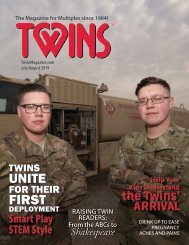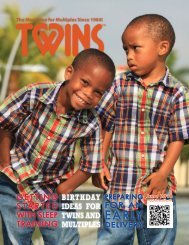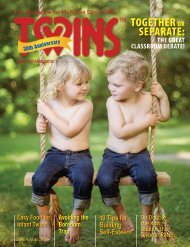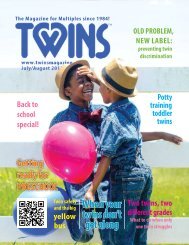2004 Guide To The First Year with Twins
In this edition: Are they twins Back to Sleep Breast feeding Your Twins Does zygosity matter Early Arrivals Getting out and about Getting Started a Basic Layette HELP! I Need Somebody Introducing Solid Foods It's Child's Play Juggling Act…one Mom's story Nicu Primer Protecting Your Child From RSV Pumping Primer SLEEPING Through the NIGHT Teething Times two The best-laid plans The early days The Road to Independece The Twin Bond Weaning Awareness Welcome Home What About Me
In this edition:
Are they twins
Back to Sleep
Breast feeding Your Twins
Does zygosity matter
Early Arrivals
Getting out and about
Getting Started a Basic Layette
HELP! I Need Somebody
Introducing Solid Foods
It's Child's Play
Juggling Act…one Mom's story
Nicu Primer
Protecting Your Child From RSV
Pumping Primer
SLEEPING Through the NIGHT
Teething Times two
The best-laid plans
The early days
The Road to Independece
The Twin Bond
Weaning Awareness
Welcome Home
What About Me
You also want an ePaper? Increase the reach of your titles
YUMPU automatically turns print PDFs into web optimized ePapers that Google loves.
When your multiples contemplate
walking, it is one of the
biggest steps toward independence
they will take. A child makes
a conscious decision to pull up, hold
on or let go and walk away. Even taking
just one or two steps causes conflict.
By their actions, babies are asking, “Should I wait, or is it
time to take a risk?” Some little ones will fall and revert to crawling
or scooting. Other children will stand upright, step out and
be on their way. Each child is different and sets a different pace.
This is important to remember when you are rearing multiples.
Early childhood expert, T. Berry Brazelton, M.D., refers to
this developmental milestone as “the calm before the storm.” He
explains that babies may exhibit new and different behavior
when entering this next, more independent stage. Your pre-toddlers
may start waking up at night, or they may experience frustration
when a parent walks away from them. They are beginning
to realize that they want to be the ones to walk away.
As soon as they start walking, children are ready for their first
shoes—soft-soled and flexible. Indoors they should be barefoot
as much as possible, to strengthen the muscles.
Twins may climb out of their cribs or play yard. Carefully
babyproof the room and anchor dressers to the wall.
Babies assert their independence in other ways as well. They
begin to develop distinct likes and dislikes. They may love
bananas one day and spit them out the next. In fact, you likely
will be surprised by how emotional their first tantrums are.
Everything they do is a learning and
The exploring experience. They can climb
Road to
up stairs but not down. Twins together
can climb furniture higher than any
Independence singleton would ever try.
The world is a rich and wonderful
place to discover. Protect your twins
and teach them how to survive physically, socially and emotionally
by setting limits.
Twins may become so stimulated by the discovery and learning
in their expanding world that they sleep less. Some 1-yearold
babies only take one nap a day. When they cut back on napping
time, they are usually cranky by dinner and it’s hard to get
them to eat. Consider making lunch the biggest meal. Bathing
them every night helps relax them—and they need more frequent
baths.
Favorite toys may be the toilet (latch the lid down), an empty
box and a kitchen cupboard filled with plastics, wooden spoons,
pots and pans. They learn to classify objects, studying shapes and
sizes. They learn that a smaller object fits inside a larger one, but
not the other way around. Every object has to be tasted, shaken,
thrown, banged and flushed. Stuffed animals begin to appeal to
a 1-year-old.
The road to independence can be a bumpy one, but it
is exciting, and if you are enthusiastic and don’t worry
much about the falls, your multiples will survive and follow in
your enthusiasm and positive outlook.
TWINPROOFING
When babies start crawling, their horizons expand tremendously
and your life becomes vastly more complicated. It’s
critical for parents to be one step ahead as the babies begin
to explore and examine their wider world. Childproofing for maximum
safety in the home is a must.
■ Use safety gates at doors and stairs.
■ Install locks on the toilet seats.
■ Relocate pet food and water dishes.
■ Move heavy objects from low tables.
■ Store medicines, cosmetics and sharp objects on high
shelves.
■ Cover all electrical outlets with baby safety plugs.
■ Put locks on the kitchen and bathroom cabinets.
■ Move house plants up off the floor and out of reach.
■ Tie up cords from window blinds.
Take a look at your world from a hands-and-knees perspective
and remove, lock, cover, relocate and eliminate any potential dangers.
Order safety items online and from these catalogs:
■ One Step Ahead, www.onestepahead.com, (800) 274-8440
■ Perfectly Safe, www.perfectlysafe.com, (800) 898-3696
■ Safe Beginnings, www.safebeginnings.com, (800) 598-8911
For safety information, contact these agencies:
■ National Safe Kids, www.safekids.org, (800) 598-8911
■ Paranoid Sisters, www.paranoidsisters.com
■ Governmental Recalls (6 agencies), www.recalls.gov
■ International Association for Child Safety, www.iafcs.com
■ American Academy of Pediatrics, www.aap.org, (847) 434-4000
32 GUIDE TO THE FIRST YEAR To subscribe to TWINS call 1-888-55-TWINS or go to www.TwinsMagazine.com

















